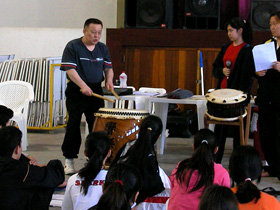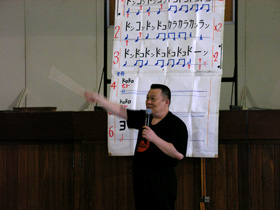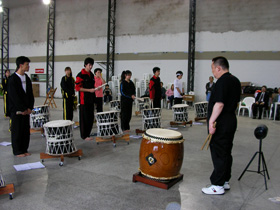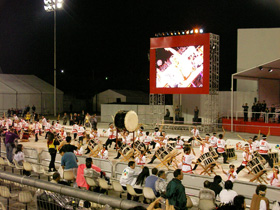Activities Overseas
Starting in 2004, for five years, Taiko Shudan Amanojaku's founder and leader, Yoichi Watanabe traveled to Brazil as a representative of the Japan Taiko Federation to teach the art of Taiko. Yoichi Watanabe took on the role of teaching over 400 children that grew up in the largest population of Japanese descent outside of Japan.He taught things such as the history of Taiko, technique, how to handle the instruments and how to properly wear costumes. Through the beat of taiko he was able to overcome the cultural and language barriers that stood between Japan and Brazil and touch each of the children's lives with his sincerity.
During his time there he was able to administer the Japan Taiko Foundation's Taiko Technical Certification Exam.
The joint piece “Kizuna's” Instructor report:
logistic obstacles
During this instructional venture nearly half (498) of what would eventually be 1000 people playing taiko at the same time were able to learn the joint piece. By taking Oguchi Daihachi Sensei's song and blending elements of “Kenka Yatai” and “Brazil Taiko Bayashi”, a version of “Kizuna” that increased the children's will and aggressiveness to learn the piece was created.
A set that allowed for a 38-39 member team to fit on a stage 20 meters wide and 12 meters deep was created. By following these members leads it is possible to line up 25 separate teams and have an additional 951 players perform at the same time. In the case of over 1000 players performing, by adding additional Odaiko those players can play parallel to the current set. Also, I created the setup in correspondence with the request from the event leaders that the players not to face their backs to the seats of the honored guests. Since the guests will be viewing from both sides all players will be facing out from the center toward the seating. The amount of taiko necessary for one team will be 12 down style (Sue-oki), 12 slant style (naname), 12 shime-daiko, and one Odaiko. Including all 25 teams the total necessary will be 300 down style, 300 slant style, 300 shime-daiko, and 25 Odaiko, in addition one metal canon (tekkan) will also be necessary.
Although it depends on the sound, when performing with about 200 players in an open space a little less than 100square meters (Marilia) a single metal canon (tekkan) was able to keep everyone together with no amplification. I'm led to think that with the use of monitor speakers the sound of the metal canon and the metal canon player's voice can keep everyone together.
During this short stay, I have taken those who remembered the joint piece and made them leaders. Giving them a sense of responsibility for the success of the 1000 player performance I put each in charge of teaching their respective groups. To help things along more quickly for new players to learn I prepared written scores of the music and a DVD of the piece for distribution.
Report of the Taiko Technical test
This time 99 people took the 5th class rating test and 58 took the 4th class. Everyone passed, bringing the total to 284 Brazilians of the 5th class and 122 of the 4th. The more people become certified the steadier our future becomes, and we can continue our exchange with Brazil.
Just like last year, when the result of the test were announced there were many children who cried tears of joy. This shows me an even deeper value to the test, it is the process and the meaning it carries for those who take it.
Report on the Instructor (as found in a local Japanese-Brazilian newspaper)
“I did it! I passed the 5th class Taiko examination!” Kaneko Kuniei
“Congratulations!” Yoichi Watanabe Sensei said to the third group at the Junjiai hihaku cultural preservation association. We had passed the Taiko Examination, and everyone was jumping up and into each other's arms.
I had heard that there was a taiko course and a 5th class Taiko Technical Certification exam. and so on July 11th, Tuesday at 5AM I took along a pair of young kids and headed for Registro. The course was that of Yoichi Watanabe (47) a First-Class certified instructor of the Nihon Taiko Foundation. Watanabe Sensei is the leader and founder of the famous “Amanojaku”. He brought his group to perform in Brazil the year before last. This was the third time that Sensei had visited us.
On the Eighth of July at the Anhembi meeting hall the 3rd All-Brazil Taiko Player Examination was held. As the jury-panel head, Watanabe Sensei carried out a very important role. This time around, he was accompanied by Isaku Kageyama (24), who was both a kind teacher as well as the right hand of Watanabe Sensei.
At 8:30 in the morning, in front of a class of 34, the lecture began. Before administering a written test Watanabe Sensei lectured on various things such as the Japanese Heart, the history of Taiko, things about the taiko itself and bachi, how to wear hanten, tie a obi, musical notes, and things dealing with rhythm in general. After we finished lunch the first part of afternoon session began. Right off the bat we were all told that we passed the written exam so we took a collective breath of relief. Sensei went on to demonstrate the traditional theatre drum patterns used to depict different natural sounds such as the sound of snow, the snow of waves, the sound of thunder, etc. After he finished demonstrating he called out individuals and had them try their hand. After that we all practiced the piece for the playing portion of the 5th class Taiko Technical Certification Exam for an hour.
The 34 of the students were split into three groups of 8 or 9 and practiced for another hour. In each group there were 2 or 3 leaders present that were eager to run the piece again and again. Then at right around 3:30PM it was time for the real deal.
In groups of eight players four played up front on Okedo taiko and four played in back on shime. After finishing the piece one time the eight players switch positions and played the piece one more time.
During the two runs of the piece, if even one person made a mistake they were made to try again. Each group had to rotate in to play infront of Sensei but even after the 1st try, 2nd try. . . 5th try or even 6th try we were unable to pass. Naturally after about the 6th attempt it became obvious in some of the children that they were starting to feel down.
When Sensei saw this he would tells us “Laugh! Keep your chin up!” but then with the sound of “dame! (No good!)” we would have attempt the piece yet again.
In the end, it was at around 5:30PM after the 7th and 8th attempts that all four groups finally passed. With that Sensei told us all “Congratulations!” and the students as well as the group leaders all burst with delight and the children cried tears of joy.
At the very end I was asked to translate a message from Sensei to all of the children. But what he said echoed powerfully in my heart. This is what he said. . .
“Everyone, today you tried your best and made it through a very strict、difficult practice as well as pass your exam. Congratulations! To be honest I was worried that there would be those who would become frusterated and cry. I also wondered if the woman who were kind enough to translate and watch over today's practice would be worried as well. I was worried about what would happen if today did not end successfully. . . Even I、 who was so strict and so hard on all of you、 cried on the inside. So why was I so strict with all of you? That is because the 5th class rating that you received in Brazil today holds merit even in Japan. Someday in the future when you visit Japan if would be horrible for you to humiliate yourself, so it was important that I held this high standard. The best thing that came out of today was the leaders stepping up and teaching all of you. I think they realized how hard it truly is to teach.”
What Watanabe Sensei said that day to the children that day is something that I think they will never forget.
General Comments on Sennin taiko (One thousand person taiko)
The large scaled theme of one thousand players playing at once, after some re-arrangement and adjustment, has really become something that can be proud of. I told Mr. Minowa “When I came in March I was really unsure if it was even possible for 1000 players to play at the same time and I thought there wasn't anything that could be done, but this time I feel very relieved! The leaders really know their stuff, and with them I feel like I can do this. Thank you very much.” He replied, “Now that you've said that I feel relieved too.”
The thing that is left that I am really still worried about is when we have to strike the drums. But as far as practicing for that goes, it seems that a samba stand will be using on the real day will come on November 3rd. As long as that goes well I predict things will go well. The really high pressure that I was feeling has lightened up quite a bit.
This was the fourth time that I have been to Brazil but the itinerary this time around was the most difficult. But that is not to say that I have held anything back, I taught with everything that I had and I'm happy with the results. Right now I am with no regrets, and feel happy with Mr. Minowashi succeeding me when I go home. I am incredibly grateful to all of those that have helped me for these past five years. From the bottom of my heart, thank you very much. Now all there is to do is pray for the success of a wonderful performance next year in June.








